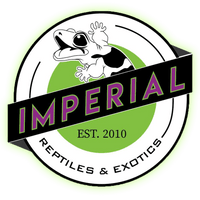Collared Lizard a.k.a Crotaphytus sp.

Intro to the Collared Lizard
The Desert Collared Lizard is a lizard native to North America inhabiting arid, rocky grasslands, and desert environments. It is easily recognizable by the two black collars encircling its neck. Along its body and tail, you'll find vibrant orange, blue or red patches complemented by various shades of tan, brown, and yellow (depending on the species). These lizards are known for their remarkable activity levels and beautiful colors, making them a fascinating sight to behold.

Collared Lizard Care
The Desert Collared Lizard is a diurnal species that exhibits high levels of activity, engaging in activities such as jumping, digging, and freely exploring its environment. To provide an optimal living space for these energetic lizards, it is crucial to create an environment that mimics their natural habitat. A minimum terrarium size of 4 x 2 x 2 (LxWxH) feet should be utilized to accommodate a single adult. This size allows for ample room to move around, regulate body temperature, and promote general healthy enrichment. It's important to avoid housing males together, but a pair of females can be kept with an adult male. Incorporate a variety of elements such as branches, rocks, tunnels, logs, and foliage to provide naturalistic features. It is recommended to include a minimum of two hiding places, such as caves, within the enclosure, although more hiding spots are highly encouraged. Ensure that these hiding spots and decorations are distributed across both the warm and cool sides of the enclosure, allowing your lizard to utilize the entire tank and feel secure.
Full-spectrum 10-16% UVB is crucial to prevent metabolic bone disease. Common substrate options include crushed walnut, zoomed reptisand (NOT CALCIUM SAND), or a dry cypress blend with play sand. Maintaining appropriate temperatures within the enclosure is vital. Daytime temperatures should range between 88 and 95 degrees Fahrenheit, with a basking spot reaching around 100 degrees Fahrenheit. Nighttime temperatures should drop to 70-75 degrees Fahrenheit. The light cycle should consist of 11-14 hours of daylight year round. Collared Lizards thrive in a humidity range of 40-50%, which can be easily achieved with minimal intervention. To facilitate shedding, it is beneficial to provide moss hides, particularly on the cooler side of the tank. The moss can be moistened by spraying it with water. Additionally, it is important to include a small water dish in the enclosure, which should be cleaned regularly. Monitor temperature with a temperature gauge and monitor humidity with a hydrometer.
As insectivores, Collared Lizards have a varied diet consisting of crickets, mealworms, superworms, roaches, bsfl, and hornworms. Offering a variety of prey items ensures that your lizard receives a well-rounded nutritional intake, as each prey item provides different nutrients. To supplement their diet adequately, it is necessary to dust the live food with calcium and multi-vitamin powders.

Collared Lizards For Sale in the Pet Trade
Due to their nervous and skittish nature, handling Collared Lizards can be challenging and not recommended.
Captive Bred Collared lizards are rare but there are some dedicated hobbyist breeders and professionals working on increasing the number of CB Collared Lizards - definitely a step in the right direction! However, it is not rare to come across wild caught specimens for sale. Wild Caught Lizards are not recommended for beginner hobbyists.
Links:


























